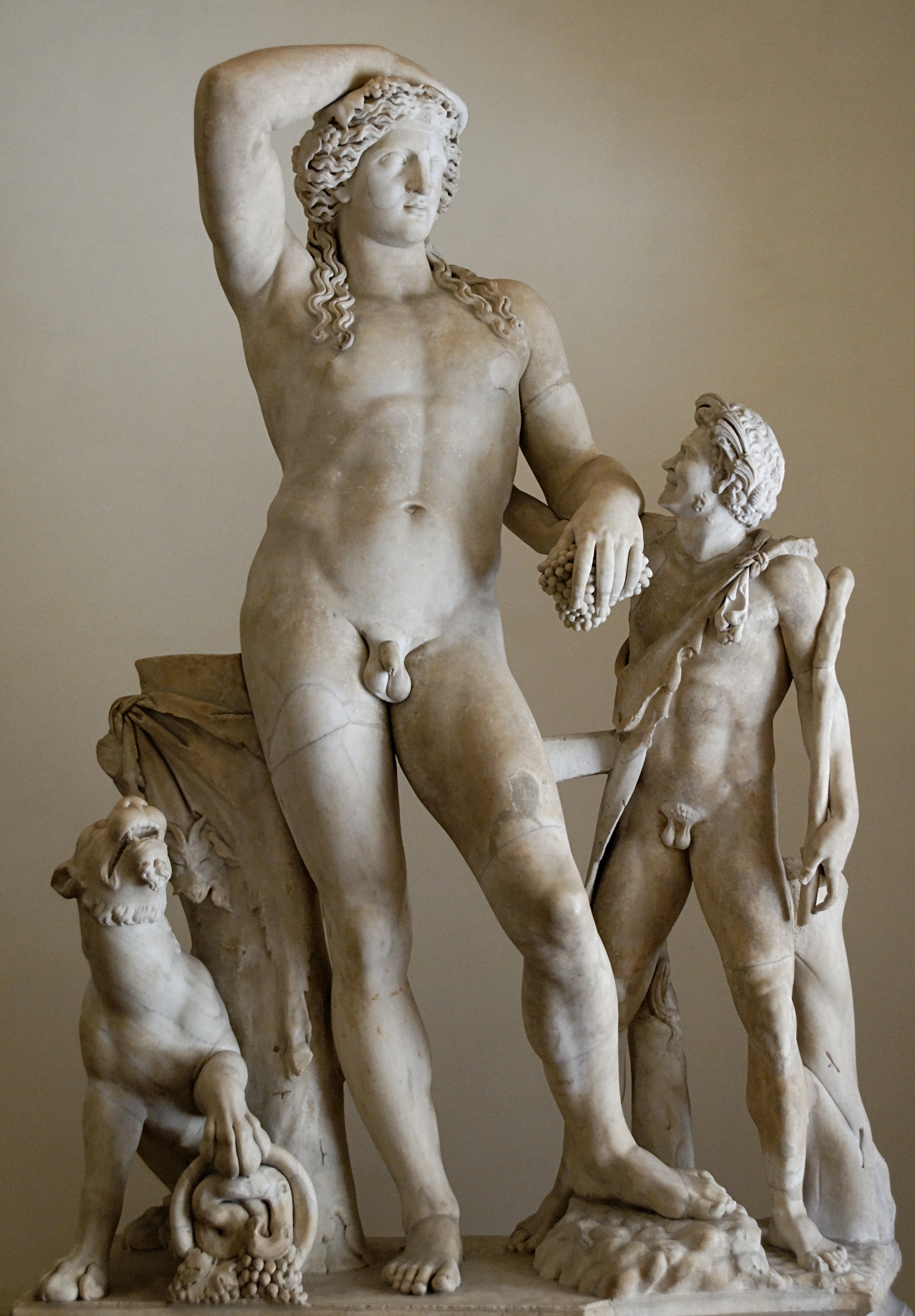Ludovisi Dionysus on:
[Wikipedia]
[Google]
[Amazon]
 The over-lifesize marble ''Dionysus with Panther and Satyr'' in the
The over-lifesize marble ''Dionysus with Panther and Satyr'' in the
 The over-lifesize marble ''Dionysus with Panther and Satyr'' in the
The over-lifesize marble ''Dionysus with Panther and Satyr'' in the Palazzo Altemps
The National Roman Museum (Italian: ''Museo Nazionale Romano'') is a museum, with several branches in separate buildings throughout the city of Rome, Italy. It shows exhibits from the pre- and early history of Rome, with a focus on archaeological ...
, Rome, is a Roman work of the 2nd century AD, found in the 16th century on the Quirinal Hill at the time foundations were being dug for Palazzo Mattei at Quattro Fontane. The statue was purchased for the Ludovisi collection Ludovisi can refer to:
*Ludovisi (family), a noble Italian family
**Ludovisi papacy of Pope Gregory XV
**Cardinals Ludovisi
*** Cardinal Alessandro Ludovisi, later Pope Gregory XV
**** Cardinal Ludovico Ludovisi (the Pope's Cardinal Nephew and O ...
, where it was first displayed in front of the ''Palazzo Grande'', the main structure of the Villa Ludovisi
The Villa Ludovisi was a suburban villa in Rome, built in the 17th century on the area once occupied by the Gardens of Sallust (''Horti Sallustiani'') near the Porta Salaria. On an assemblage of vineyards purchased from Giovanni Antonio Orsini, ...
, and by 1641 in the gallery of sculptures in the ''Casino Capponi'' erected for Cardinal Ludovico Ludovisi in the villa's extensive grounds. By 1885, it had been removed to the new Palazzo del Principe di Piombino, nearby in via Veneto. With the rest of the Boncompagni-Ludovisi collection, which was open to the public on Sundays and covered in the guidebooks, and where it had become famous,"The youthful, or so-called Theban Bacchus, was carried to ideal beauty by Praxiteles
Praxiteles (; el, Πραξιτέλης) of Athens, the son of Cephisodotus the Elder, was the most renowned of the Attica sculptors of the 4th century BC. He was the first to sculpt the nude female form in a life-size statue. While no indubita ...
... The finest statue of this kind is in the villa Ludovisi" (William Smith, ''A New Classical Dictionary of Greek and Roman Biography, Mythology and Geography'', 1871, ''s.v.'' "Dionysus"); "...the eyes most intense and soft; the hair in curls, close to the head, brown with streaks of gold, strangely resembling the hair of some Greek statue — perhaps the Ludovisi Bacchus..." ( William Francis Barry, ''Arden Massiter'', 1900, p. 16.) it was purchased in 1901 for the City of Rome, as the Ludovisi collection was dispersed and the Villa's ground built over at the end of the 19th century.
The formula, with somewhat exaggerated ''contrapposto
''Contrapposto'' () is an Italian term that means "counterpoise". It is used in the visual arts to describe a human figure standing with most of its weight on one foot, so that its shoulders and arms twist off-axis from the hips and legs in the ...
'', the god's right hand resting on his head, is based on the Apollo Lyceus
The Apollo Lyceus ( el, Ἀπόλλων Λύκειος, ''Apollōn Lukeios'') type, also known as Lycean Apollo, originating with Praxiteles and known from many full-size statue and figurine copies as well as from 1st century BCE Athenian coinage ...
, which is variously attributed and dated. This ivy-crowned Dionysus
In ancient Greek religion and Greek mythology, myth, Dionysus (; grc, wikt:Διόνυσος, Διόνυσος ) is the god of the grape-harvest, winemaking, orchards and fruit, vegetation, fertility, insanity, ritual madness, religious ecstas ...
is accompanied by the panther
Panther may refer to:
Large cats
* Pantherinae, the cat subfamily that contains the genera ''Panthera'' and ''Neofelis''
**'' Panthera'', the cat genus that contains tigers, lions, jaguars and leopards.
*** Jaguar (''Panthera onca''), found in S ...
that signalises his numinous presence, and a satyr
In Greek mythology, a satyr ( grc-gre, σάτυρος, sátyros, ), also known as a silenus or ''silenos'' ( grc-gre, σειληνός ), is a male nature spirit with ears and a tail resembling those of a horse, as well as a permanent, ex ...
of reduced size, a member of his retinue. Long locks of his hair fall girlishly over his shoulders and in his left hand he holds a bunch of grapes, emblem
An emblem is an abstract or representational pictorial image that represents a concept, like a moral truth, or an allegory, or a person, like a king or saint.
Emblems vs. symbols
Although the words ''emblem'' and '' symbol'' are often use ...
atic of his status as god of wine
Wine is an alcoholic drink typically made from Fermentation in winemaking, fermented grapes. Yeast in winemaking, Yeast consumes the sugar in the grapes and converts it to ethanol and carbon dioxide, releasing heat in the process. Different ...
.
The original elements are the heads, torsos and thighs of Dionysus and the satyr. The arms of the satyr and the lower legs and base are modern— that is, 16th-century— restorations.
Notes
References
*Venetucci, Beatrice Palma. ''Museo Nazionale Romano. Le Sculture'' vol. I.4, Antonio Giuliano ed., Rome, 1983:84-90 Dionysus in art Ludovisi collection Collections of the National Roman Museum Hellenistic-style Roman sculptures Archaeological discoveries in Italy Sculptures of men in Italy {{Italy-sculpture-stub